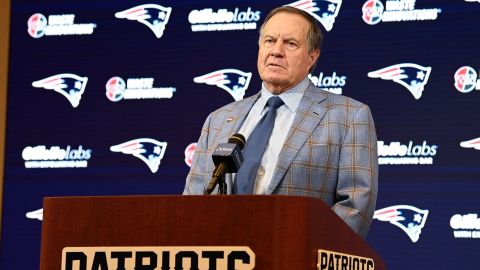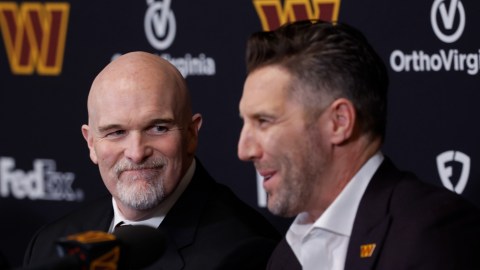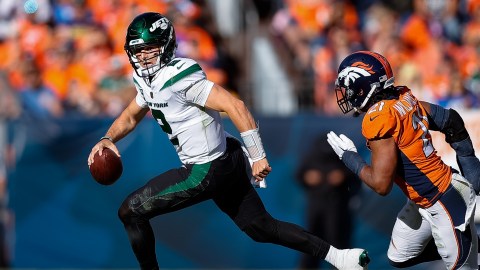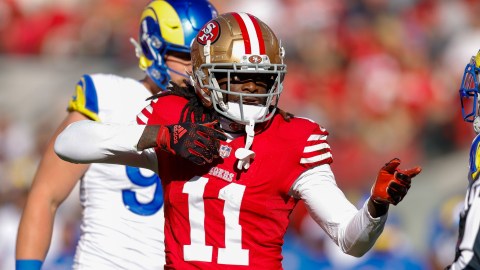 When you think of the best wide receivers in the NFL, your mind immediately goes to players like Calvin Johnson, Larry Fitzgerald, A.J. Green, Roddy White and Julio Jones. All of those players combine elements of speed, strength, route running and solid hands. Further down the line, you may start to think of wideouts like Desean Jackson, Wes Welker and Demaryius Thomas — players who excel in one aspect, but lack the overall game that the top wide receivers in the league possess. Mike Wallace belongs in that second group, but he’s about to be paid like he’s in the first.
When you think of the best wide receivers in the NFL, your mind immediately goes to players like Calvin Johnson, Larry Fitzgerald, A.J. Green, Roddy White and Julio Jones. All of those players combine elements of speed, strength, route running and solid hands. Further down the line, you may start to think of wideouts like Desean Jackson, Wes Welker and Demaryius Thomas — players who excel in one aspect, but lack the overall game that the top wide receivers in the league possess. Mike Wallace belongs in that second group, but he’s about to be paid like he’s in the first.
Reports came out on Sunday that Wallace is expected to be paid an average of $13 million per season when he signs on with a new team after the league start date of March 12. For any team rumored to be in on Wallace, that’s a terrifying number.
Wallace is one of the fastest wide receivers in the league. He proved that coming out of Ole Miss in 2009 when he ran a blazing 4.28-second 40-yard dash at the NFL combine. Of course, there are plenty of speedy wide receivers that never panned out in the NFL (Patriots fans, may we remind you of Chad Jackson and Bethel Johnson). Wallace has already panned out, but that doesn’t mean he’ll be able to develop into a Johnson, Fitzgerald or White to live up to that hefty price tag.
Wallace lacks route-running skills, he lacks strength to get separation over the middle and his agility is average compared to his speed. Where Wallace truly excels is using his long speed to go deep and fly past opposing defensive backs. That sounds a bit like Randy Moss, right?
Well, kind of. Moss is 6-foot-4, though — compared to Wallace, who’s 6-foot — and requires less deep accuracy from his quarterback to consistently hit him on those long passes. Due to Wallace’s height, he relies heavily on his quarterback to have any consistency. Take 2012 for example.
When Ben Roethlisberger was injured for most of four games, Wallace caught just 13 passes on 29 targets. He had 91 yards, averaging 22.75 yards per game. Wallace did not catch a touchdown from Byron Leftwich or Charlie Batch during that span. During Wallace’s 11 games with Roethlisberger, he caught 51 passes on 90 targets for 745 yards and eight touchdowns. He averaged 67.73 yards per game.
Obviously any wide receiver will struggle when his quarterback is out. But that was a major drop off in production that should be a red flag.
Wallace’s best season in the league, 2010, came when Roethlisberger was at his best in down-field accuracy. That season, Roethlisberger was seventh in the league in completion percentage on passes over 20 yards at 46.3 percent, according to Pro Football Focus. Wallace was ninth in the league on deep passing catch rate at 48.3 percent. In 2011 that number dropped to 41.7 percent and in 2012 it dropped further to 19.4 percent — 54th in the league and seventh worst.
Any team that wants to spend $13 million on Wallace will likely look at that 2010 season when he had 60 receptions for 1,257 yards and 10 touchdowns for a mind boggling 21 yards per reception. The problem is, that may be his ceiling rather than his upside.
Wallace has been tried in different roles. Other than on deep routes, he excels on any route where he can exploit a cornerback that’s giving him too much padding. With Wallace’s speed, sometimes the defense respects him a little too much.
In the past four years, Wallace has also been played in the slot more than you may think — around 82 snaps per season. On those plays he has been targeted 41 times. He has only caught 15 passes, while dropping five. He has a catch rate of 36.6 percent in the slot, and a drop rate of 12.2 percent. To compare that to a good slot receiver, Welker has a catch rate of 75 percent and a drop rate of just 7.1 in that same span.
That’s not to say that Wallace would be used in the slot often wherever he goes, but it does highlight his weaknesses as a player. Wallace has a tendency to shy away from contact, and when he’s challenged for a ball, he won’t stand up to competition. The same holds true whether he’s going over the middle or going deep.
For a team to spend $13 million per season on a player, or roughly 10 percent of the cap, you have to deliver more consistency than Wallace offers. A player of that caliber should be more versatile. Surely no one would argue that Wallace is as complete as an Andre Johnson or Reggie Wayne, and because he offers a limited skill set, it makes sense the former Steeler be paid more like Welker than a top wideout.
Obviously Wallace will make whatever team he goes to better. He’s consistently among the league leaders in yards per catch and yards per target, and he’s a dangerous piece to any offense. But his inconsistency, lack of versatility and dependency on who is throwing him the ball should be a concern for anyone.
Photo via Facebook/Pittsburgh Steelers from B/R




